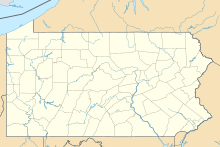Carnegie Museum of Art
This article contains content that is written like an advertisement. (October 2019) |
This article or section may have been copied and pasted from another location, possibly in violation of Wikipedia's copyright policy. (May 2021) |
 Exterior view of the Sarah Mellon Scaife Gallery. | |
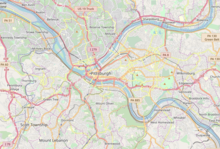 Location of CMMA in Pennsylvania. | |
Former name | Department of Fine Arts, Carnegie Institute |
|---|---|
| Established | November 5, 1895 |
| Location | 4400 Forbes Ave, Pittsburgh, Pennsylvania 15213 |
| Coordinates | 40°26′37″N 79°56′56″W / 40.443690°N 79.948976°W |
| Type | Art Museum |
| Accreditation | American Alliance of Museums |
| Visitors | 500,000 (2018) |
| Director | Kevin Hiles |
| Curator | Eric Crosby |
| Historian | Ellen Baxter |
| Nearest car park | On site and street |
| Website | cmoa |
The Carnegie Museum of Art, abbreviated CMOA, is an art museum in the Oakland neighborhood of Pittsburgh, Pennsylvania. The museum was founded in 1895 by the Pittsburgh-based industrialist Andrew Carnegie.[1] The museum collects contemporary art, including film and video works. It was the first museum in the United States with a primary focus on contemporary art.[2] As instructed by its founder Andrew Carnegie at the inception of the Carnegie International in 1896, the museum has been organizing many contemporary exhibitions that showcase the "Old Masters of tomorrow".[3]
History[]
The museum's origins can be traced to 1886 with Andrew Carnegie's initial concept:[4] "I am thinking of incorporating with the plan for a library that of an art-gallery in which shall be preserved a record of the progress and development of pictorial art in America." Dedicated on November 5, 1895, the art gallery was initially housed in the Carnegie Libraries of Pittsburgh Main Branch in Oakland.
Carnegie envisioned a museum collection consisting of the "Old Masters of tomorrow" and the Carnegie Museum of Art became, arguably, the first museum of modern art in the United States. The museum received a major expansion in 1907 with the addition of the Hall of Architecture, Hall of Sculpture, and Bruce Galleries, with funds again provided by Carnegie.[5]
Under the directorship of Leon Arkus, the Sarah Mellon Scaife Gallery (125,000 square feet) was built as an addition to the existing Carnegie Institute. Designed by architect Edward Larrabee Barnes, it first opened in 1974 and more than doubled the museum's exhibition space, plus added a children's studio, theater, offices, café, and bookstore.[6] The New York Times art critic John Russell described the gallery as an "unflawed paradise." The gallery has been renovated several times since its original creation, most recently in 2004.
Today the museum continues Carnegie's love of contemporary art by staging the Carnegie International every few years. Numerous significant works from the Internationals have been acquired for museum's permanent collection including Winslow Homer's The Wreck (1896) and James A. McNeill Whistler's Arrangement in Black: Portrait of Señor Pablo de Sarasate (1884).
Collections and departments[]

The museum's curatorial departments include: Fine Arts (Contemporary Art, Works on Paper), Decorative Arts, Architecture, and Photography. The museum presents as many as 15 changing exhibitions annually. Its permanent collection comprises roughly 35,000 works and includes European and American decorative arts from the late seventeenth century to the present, works on paper, paintings, prints (notably Japanese prints), sculptures and installations. The museum has notably strong collections of both aluminum artifacts and chairs. Approximately 1,800 works are on view at any given time.
In 2001, the museum acquired the archive of African-American photographer Charles "Teenie" Harris, consisting of approximately 80,000 photographic negatives spanning from the 1930s to the 1970s. The museum is working with a Teenie Harris Advisory Committee to identify the photographs. Many of these images have been catalogued and digitized and are available online via the Carnegie Museum of Art Collections Search.
Heinz Architectural Center - The collection includes works in architecture, landscape design, engineering, and furniture and interior design. The center's facilities includes 4,000 square feet of exhibition space and a library housing several thousand books and journals.
The Hillman Photography Initiative - The Initiative hosts a variety of projects including live public events, web-based projects, documentary videos, art projects, and writing. Yearly programming is determine by a group of five "agents" who plan and curate each 12 month cycle of works hosted. [7]
Collection Themes
- Contemporary Glass
- Teenie Harris Photographs: Erroll Garner and Jazz from the Hill
- Carnegie International
- Japanese Prints
- Pittsburgh Artists
- The Art of the Chair
- Pictorialist Photography
- Painting and Sculpture 1860–1920
- W. Eugene Smith
Galleries[]
This section needs additional citations for verification. (May 2021) |
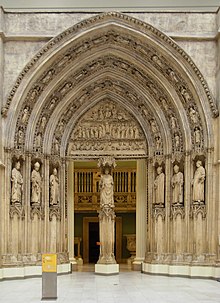
- Ailsa Mellon Bruce Galleries (1907) – originally constructed display reproduction bronze casts from Pompeii and Herculaneum. Renovated in 2009, the galleries exhibit more than 500 objects representing American and European decorative arts from the Rococo and Neoclassical periods of the 18th century to contemporary design and craft.
- Hall of Architecture (1907) – Today the Hall of Architecture houses almost 140 full-size plaster casts of elements of buildings found in the ancient and classical civilizations of Egypt, Greece and Rome, and from Romanesque, Gothic and Renaissance Europe. As such, it is the largest collection of plaster casts of architectural masterpieces in America and one of the three largest in the world, along with those of the Victoria and Albert Museum in London and the Musée national des Monuments Français in Paris.
- Hall of Sculpture (1907) – modeled upon the Parthenon's inner sanctuary, and originally created to house the museum's 69 plaster casts of Egyptian, Near Eastern, Greek, and Roman sculpture. Today it exhibits works from the permanent collections, with its balcony displaying decorative arts objects from the eighteenth to the twentieth century.
- Heinz Architectural Center (1993) – dedicated to the collection, study, and exhibition of architectural drawings and models.
- Scaife Galleries – Focused primarily on European and American art since 1850, but also including collections of African art, classical and Egyptian art, and older European and American art.
- Works on Paper Gallery
- Forum Gallery – Located on the first floor of the museum just inside the Forbes Avenue entrance, this single room is dedicated to temporary exhibitions of contemporary art. It opened November 3, 1990 with support from the National Endowment of the Arts. The first exhibition, Forum 1, was a solo show of Jeff Wall. Subsequent exhibitions were numbered sequentially (for example, Forum 40 featured Felix de la Concha). Unlike larger museum exhibitions, which can take up to three years to plan and execute, Forum shows come together relatively quickly, and are open to any curatorial staff's vision. In the words of Vicky Clark, a longtime curator at the museum, "The idea was to make sure that we had an exhibition of contemporary art set up at all times."[8]
Educational programs[]
Saturday art classes in the galleries of Carnegie Museum of Art have been conducted for over 75 years. Alumni of the program include Andy Warhol, photographer Duane Michals, and contemporary artist Philip Pearlstein. The museum has classes specific to various age groups.[9]
Gallery[]
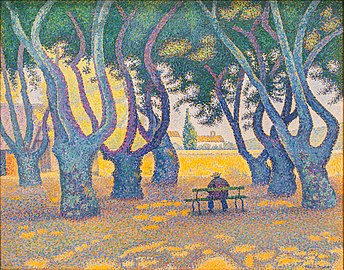
Place des Lices, 1893, oil on canvas, Paul Signac
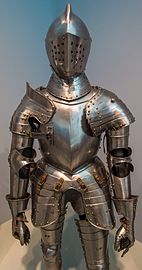
Armor, with Helmet, circa 1555, Anton Peffenhauser

Ivory portable altar, 14th Century, French
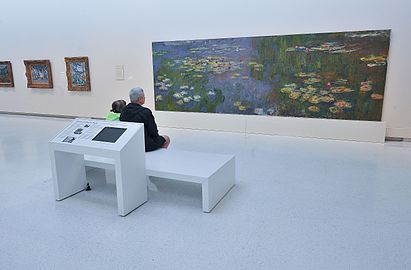
Water Lilies (Nymphéas), 1915–1926, oil on canvas, Claude Monet
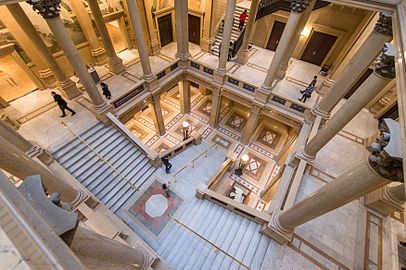
The 1907 Grand Staircase

Bronze ritualistic vessel, 1300-1150 B.C.E., Shang Dynasty, China
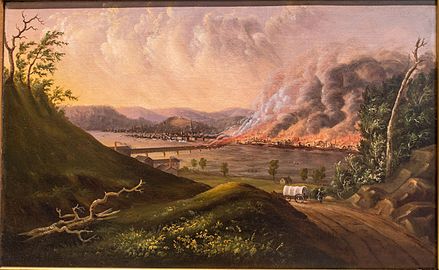
View of the Great Fire of Pittsburgh, 1846, oil on canvas, William Coventry Wall

Housepost, circa 1930's, Yoruba Culture, Africa

Ancient Greco-Roman vase
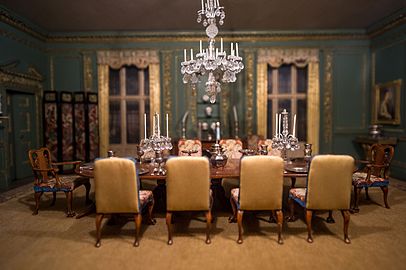
Miniature room on display, Ruth McChesney

Wheat Fields After the Rain (The Plain of Auvers), 1890, oil on canvas, Vincent Van Gogh

Casket for relics of a saint (châsse), 13th Century, French

Steamboat on the Ohio, 1896, oil on canvas, Thomas Pollock Anshutz

Farallon Island, 1887, oil on canvas, Albert Bierstadt
See also[]
- Andrew Carnegie
- Carnegie Museums of Pittsburgh
- Homer Saint-Gaudens
- Frick Art & Historical Center
- List of museums in Pennsylvania
- Sally Dixon
References[]
- ^ About Carnegie Museum of Art: History Archived October 13, 2008, at the Wayback Machine[self-published source?]
- ^ "History". Carnegie Museum of Art. Retrieved 2020-10-19.
- ^ Micucci, Dana (2008-05-30). "Carnegie Museum, in Pittsburgh, shows contemporary art's". The New York Times. ISSN 0362-4331. Retrieved 2018-02-07.
- ^ W. J. Holland, LL.D., "The Carnegie Museum", in Popular Science, May 1901.
- ^ Memorial of the celebration of the Carnegie Institute at Pittsburgh, Pa., April 11, 12, 13, 1907.
- ^ Ellen S. Wilson, "The Continuing History of the Scaife Galleries", in Carnegie Online, July/August 2003 "Archived copy". Archived from the original on 2008-09-07. Retrieved 2009-11-29.CS1 maint: archived copy as title (link).
- ^ Hillman Photography Initiative Announced
- ^ Pifer, Jenelle (Winter 2015). "The Art of the Now". Carnegie. Carnegie Museum of Art: 24–29.
- ^ "School of Rock, Art, and Science". Carnegie Museums of Pittsburgh.
External links[]
| Wikimedia Commons has media related to Carnegie Museum of Art. |
- Carnegie Museum of Art
- 1896 establishments in Pennsylvania
- Andrew Carnegie
- Art museums established in 1896
- Art museums in Pennsylvania
- Asian art museums in the United States
- Edward Larrabee Barnes buildings
- Institutions accredited by the American Alliance of Museums
- Modern art museums in the United States
- Museums in Pittsburgh
- Plaster cast collections
- Tourist attractions in Pittsburgh
